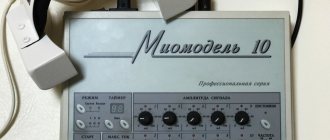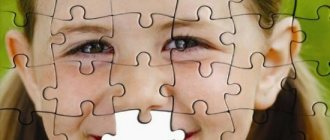Speech is the main tool for human interaction. However, adults often forget how complex the process of oral communication is until a child appears in the family who is just learning to pronounce his first sounds and put them into words, and later into phrases and sentences.
Just think about it: it takes years for a child to fully master oral speech! From birth, the child trains his tongue, vocal cords and facial muscles; his brain processes sounds coming from outside, analyzes them and issues a command for playback.
An adult bending over the cradle is touched by the first babble, and for a child this is not only the first attempts at communication, but also training. And how many words does a child need to remember! At the same time, the baby should not only be able to reproduce a combination of sounds, but also correlate them with objects, processes and phenomena around him.
Thus, a child’s speech development is a colossal work of the brain. And it should be practically completed by seven years. At the same time, speech development refers to the stages and processes associated with the child’s acquisition of oral and written speech.
What is included in the concept of “speech development”?
Parents often understand speech development as a rather narrow area. For example, the active vocabulary of a child of a certain age often seems to adults to be the only criterion for harmonious speech development. Others pay special attention to the purity of pronunciation of sounds. Still others look at the length and complexity of sentences composed after the age of three.
Depending on what adults mean by the concept of “speech development,” their linguistic behavior towards the baby will also differ significantly. Someone insists that the child memorize as many poems as possible, someone tries to “put into his head” as many different concepts and meanings as possible, and someone insists on daily repetition of pure sayings.
However, this concept is too broad to focus on any one component. After all, the ultimate goal of a child’s speech development is to teach him to competently and accurately express his thoughts and describe phenomena. The development of speech is closely related to the formation of verbal thinking, the assimilation of the laws of communication and much more.
To better understand how to help a child not just learn to speak, but to comprehensively develop his speech, one should dwell in more detail on the main stages of its formation.
Origin of thinking and speech
Although thinking and speech existed side by side with each other during the development of mankind, they are still separate, independent concepts. It is believed that speech arose for the process of interaction of people with each other in the course of some common purposeful activity for its more effective implementation, and the process of thinking existed separately from it. This can be seen in the example of animals and their effective approach to any small tasks facing them, which they are able to solve despite the lack of speech.
Initially, speech was a tool to characterize some necessary knowledge about subjects acquired during work for a better understanding and characterization. Thus, speech was necessary for a more effective existence. Such speech, naturally, was not as rich as the one we use today. It consisted of separate semantic units that were used as whole sentences and sometimes had several meanings at the same time, completely different in meaning. At this time, due to the polysemy of speech units, speech was used directly during the performance of any action or living in a situation. It is curious that during the development of speech in children, a somewhat similar use of words is observed and a child can use the same word to characterize a whole group of objects that at first glance may not be related to each other.
Subsequently, as speech develops, it increasingly moves away from purely practical use and inner speech arises, which plays an important role in the thinking process. Inner speech makes it possible to think not only directly while performing a practical task, but also for internal comprehension of any action, creating an idealized imaginary model of an event or phenomena. In principle, such a powerful and important tool of thinking as imagination arises, which allows, among other things, to predict any events without direct participation in them. Thanks to the new possibilities of developed thinking, speech further develops to satisfy the needs of thinking.
The process of joint growth of thinking and speech becomes inseparable.
Stages of speech formation in a child
Any parent knows that speech does not develop overnight. This is a long process. At each age, the child and the adults around him are faced with various tasks regarding the development of the native language by a small family member. Conventionally, the development of speech can be divided into stages, although, of course, the boundaries between them cannot be clear.
From birth to 1 year - pre-speech stage
Despite the fact that during this period the child does not yet speak, he is already actively mastering human speech. He listens to songs and flows, tries to pronounce and diversify his first sounds.
This stage is conventionally divided into stages:
Buzz stage
The walking stage occurs between 1.5 and 2 months of age. During this period, the baby makes his first sounds, which so often touches the parents. Then the sounds begin to form chains: “aaaa-uu-aa-aa.”
Babbling stage
The babbling stage is from 4-5 months to 7-8 months. During this period, in the baby’s humming one can already distinguish not only vowels, but also consonant sounds, it becomes more melodic. The combination of sounds already resembles syllables.
At the same time, the baby begins to understand speech addressed to him. He turns his head when his name is called. The child reacts actively to everything he hears. In response to spoken speech, he hums more actively, already trying to “communicate.”
Lipid words stage
The stage of lipid words is from 7-8 months to 9-10 months. Stage of "children's" words. Now the child is already collecting sounds into words, which often do not have a specific meaning, but his humming becomes similar to speech. The syllables form bizarre combinations.
The child not only perfectly understands his name, but also simple words: “no”, “yes”, “na”.
First words stage
The stage ends with the stage of the first words. It occurs at the age of 9-10 months in girls and 11-12 in boys. The child already masters several words, usually including repeated paired syllables: “ma-ma”, “dya-dya”, “ba-ba”, “pa-pa”.
Thus, if a child has certain problems with the hearing or speech apparatus, parents understand this now. In this case, the baby does not hum or pronounce the first sounds at the pre-speech stage.
How can I help my child?
The fact that a child does not speak yet is not a reason to limit his communication. Quite the opposite. Communicate with your baby most of the time, trying to follow certain rules:
- Use short nursery rhymes during massage, bathing, playing with the baby, combine spoken words with actions, touch parts of the baby’s body when you name them, show voiced objects.
- Respond to your baby's noises. Make sounds with him.
- When communicating with your child, do not forget about visual contact. It is important for the child that the speech is addressed to him personally.
- Show your baby the objects around him, naming them. Tell him about your actions.
- Speak clearly and as slowly as possible.
- At this age, it is still acceptable for a parent to use “childish” forms of words in his speech: “am-am,” “bi-bi,” “tu-tu.” This will allow the child to more easily engage in the communication process.
Do not forget that the development of speech is closely related to tactile sensations and the development of motor skills. Use massage, encourage your baby to grasp and hold toys, and use play equipment made from various materials.
From a year to 1.5 - accumulation of a passive vocabulary
After a year, many parents notice that the baby is in no hurry to learn new words and include them in his speech; he only uses familiar concepts mastered at the age of one.
Be patient. The process of speech development goes much faster than it seems. By the age of one and a half years, a normally developing child pronounces only 10 simple words, but already knows about 200 names of objects and phenomena. Now it is important to be attentive to the baby in order to adequately assess the number of words addressed to him that he understands, and to help him accumulate a passive vocabulary.
At this stage of development, the baby already recognizes everyday objects and actions, he understands what it means to “swim”, “walk”, “eat”, he can show familiar objects, his favorite mug, window, his crib, high chair, etc. Turns his head and looks at the named toy.
How can I help my child?
Of course, continue to communicate! There is no need to try to “learn” new words with your child now, just talk to him, show him new objects, repeat the names of already familiar ones.
When communicating with your baby, follow these rules:
- Continue to speak clearly and slowly. Speech should be simple and clear.
- Show your baby new objects, offer to touch them and study them thoroughly. Use visual aids. It is important for a child not only to hear words, but also to correlate them as fully as possible with visual and tactile images.
- Gradually eliminate “baby” abbreviations (“pi-pi”, “am-am”) from your speech, replace them with full words (“write”, “eat”).
- Describe to your child what he sees, hears, feels.
- Invite your child to carry out simple instructions: show a toy, come up, give a pen.
- Name the objects that the baby points to with gestures, encourage the child to verbally express his wishes: “This is a pyramid. Shall I give you a pyramid?
Make sure your child understands what is being said to him. If you notice that the baby does not understand the requests made to him, simplify them, show clearly what you mean.
From 1.5 years to 2.5 years - “lexical explosion” and transition to phrasal speech
Many have heard stories about how a child “didn’t speak” and suddenly began chattering incessantly, surprising parents with the number of new words.
This phenomenon is called “lexical explosion”. Now the baby actively extracts words from the passive dictionary and learns to use them. As a rule, this phenomenon occurs over a period of 1.5 years to 1 year and 6-8 months. The transition to the next stage at 2 years is not considered a deviation from the norm; as a rule, this is observed in boys.
Almost immediately after the lexical explosion, the next stage of the child’s speech development begins—the transition to phrasal speech. It is possible when the baby’s vocabulary accumulates about 40-60 or more words.
The first two-word sentences appear in the child’s speech. At the same time, the expansion of the dictionary continues. By the age of 2.5 years, the sentences used by the child already include three to four words, and the vocabulary expands to 200-300 words.
It is considered normal to use simplified forms of words, for example “bi-bi” instead of “car”, “am-am” instead of “eat”. Such “baby” abbreviations can also be considered part of a child’s vocabulary.
Not all words can be pronounced correctly; some are even indicated by sounds - this is the norm. The baby’s first sentences may sound like this: “Mom, dem am-am” (“Mom, let’s go eat”). This is normal speech for a child of this age. But if a child does not try to form simple sentences from words by the age of 2.5, it is worth consulting with a specialist.
How can I help my baby?
The rules remain the same - continue to talk with the child, play with him, create different situations and talk through them. Don’t forget about the development of fine motor skills: encourage your child to sculpt, draw, and sort through small objects.
Make your own speech more complex when talking to your baby:
- Use a variety of forms of presenting information (poems, songs, rhymes, fairy tales).
- Continue to speak clearly and intelligibly, but at a normal speed.
- Turn your narration about objects and phenomena into a short story. Use adjectives, pronouns, and adverbs widely in your speech.
- Enter into a dialogue with your child, listen to him carefully, without interrupting and letting him speak.
- Encourage your baby to talk (smile, nod, ask questions).
- Tactfully correct incorrectly pronounced words and “childish” expressions in your child’s speech. For example, a baby says: “Mommy is coming!” - the mother immediately reacts: “Yes, the dog is coming.” Here you can go to the description: “The dog says “av-av”, it has long and shiny hair, long paws and a short tail.”
- Help your child complicate his own speech: “Dem go for a walk” - “Danila wants to go for a walk on the street.”
- Complicate tasks aimed at understanding spoken speech. Invite your child to bring objects that are not in his field of vision, ask other adults to find a specific toy, or choose a picture or cube with a specific image from a variety. Voice not just one action, but their sequence: “please go to the kitchen, pick up a cup on the table and bring it to me.”
2.5-4 years - stage of mastering coherent speech
After 2.5 years, the baby’s speech becomes more understandable.
He should already be able to pronounce many sounds correctly. However, difficulties with pronouncing the sounds “l”, “r”, “z-s” and hissing sounds (“zh-sh”, “ch-sch”) are still normal. A child's speech at the age of three should be at least 70% understandable to strangers. This is one of the criteria by which it is possible to identify deviations in the development of the baby. Normally, by the age of three, a child masters about 500-800 words, and by the age of four he should know about 1000-1500 words.
At the age of 3 to 4 years, the baby already masters certain grammatical forms, can speak in sentences and combines several sentences according to their meaning, that is, can compose a whole phrase. Adjectives, adverbs (high, late, cold, etc.), pronouns appear in his speech, words can change in number and gender.
How can I help my child?
Continue to make your speech and tasks addressed to your baby more complex. Try to visit new places and introduce your child to new phenomena.
Now the adult, in a conversation with the child, ceases to be primarily a storyteller and tries to listen more and encourage the child to communicate:
- Ask your child questions: “What happened in kindergarten today?”, “Who are you friends with? Why?”, “Tell me how you spent the day at your grandmother’s?” Invite your child to describe the rules of the game, tell the plot of a fairy tale he read, and think about it.
- Don't interrupt your child if he wants to speak.
- Help your child choose words to compose a sentence.
- Tactfully correct your little one’s speech mistakes, but only after he completes the phrase.
Also pay attention to the clarity of the child’s speech and difficulties with pronouncing certain sounds. If necessary, contact a speech therapist - now it is easier to create or correct sounds than at school age. Normally, after 4 years of age, a child already actively uses his native language. His speech continues to be improved and corrected.
Of course, the above stages do not have clear boundaries and may vary depending on the developmental characteristics of a particular child. For example, in boys the timing can shift by as much as four to five months; for girls, as a rule, this is not typical - their delay in speech development is considered normal if it does not exceed 2-3 months.
There are no absolutely strict standards regarding the number of words spoken. For example, a child can use only 7 words at one year of age instead of the “supposed” 10, and up to 2.5 he can use simpler forms of words and even come up with his own.
What else do you need to know about speech development?
Remember that speech development is a complex process and at some point failure may occur. Carefully monitor how your baby’s speech improves so that you can take corrective measures in a timely manner. Pay close attention to the critical periods of speech development. There are three of them:
- 1 critical period: from 1 year to 2 years. There is an active development of the areas of the cerebral cortex responsible for speech. During this period, the development of allalia (absence or underdevelopment of speech while maintaining mental abilities) and delayed speech development are possible. Now it is necessary to be very careful about the child’s behavior in the event of any head impacts or concussions.
- 2 critical period: 3 years. There is an active development of coherent speech. At this age, the risk of developing such deviations as mutism (the child spoke and suddenly “does not want” to respond to the addressed speech, does not try to start a dialogue) and stuttering increases. Now the baby needs a calm environment more than ever. It is worth monitoring your own speech - do not jabber, take pauses so that the child can speak out.
- 3 critical period: 6-7 years. During this period, a “disruption” of nervous activity may occur. This is fraught with the development of stuttering and childhood aphasia (partial or complete loss of previously present speech). Try to protect your child from stress and help him cope with the increased workload due to entering first grade.
Remember that speech development is associated with intensive work of the child’s nervous system. And this process will be much better in a calm and warm atmosphere. Protect your baby from worries, do not conflict with his family in front of him, talk to him kindly.
Read to your child more, moving from simple works to more complex ones. As soon as the child is able to express his opinion regarding the completed works, discuss each fairy tale or story after reading, invite the child to retell the content in his own words.
Adults need to monitor their own pronunciation and try to speak emotionally and expressively. This will not only allow the baby to master speech, but also use it for its intended purpose - as a subtle tool for expressing his own emotions.
In order for a child’s speech to develop correctly, it is necessary that he is constantly in a language environment. But don't overload him with information! It is better to use a few descriptive sentences and wait for the child's reaction, inviting him to "dialogue", rather than just chatting incessantly. For the same reason, do not replace personal communication with your child by watching cartoons and listening to audio fairy tales. Speech develops in dialogue!
The nature of speech
Speech is a structure used by man since time immemorial. In this regard, there is no clear answer to the question of whether the human ability to speak is innate, or whether speech is an acquired skill for everyone. There are different approaches to this issue, taking one side or the other.
For example, people who grew up without interaction with society cannot master any human language, which would seem to indicate that speech is an acquired skill.
At the same time, there are facts that suggest that speech is an innate ability. The baby is able to recognize the sound of human speech among many other similar sounds. Another interesting phenomenon is that in all children the development of speech skills occurs according to the same pattern, which partly also speaks of certain innate abilities for speech.
There are many hypotheses suggesting the origin of speech. Below are some of them:
- Learning Theory;
- Chomsky's theory of specific inclinations;
- Piaget's cognitive theory;
- Psycholinguistic theory of speech development.
Learning theory
Learning theory suggests that from birth a child is inclined to imitate. He first imitates sounds, then words, and then clumsily constructs his first sentences. His first words usually play the role of sentences that briefly describe his desires and motives, an excellent example here would be the word “am” used by kids, which can simultaneously mean both his desire to snack and what he is eating at the moment.
The child receives positive reinforcement from the parents after pronouncing the first sounds and then words, partly this helps him learn new words and grammatical structures and remember them. But what is surprising is that at the stage of sentence formation, parents usually encourage more competent logical conclusions and inventions, and not the correctness of grammatical structures as such. Contrary to this, the child also learns grammatical rules. Also, this theory does not take into account the child’s ability to form words and the child’s very rapid acquisition of speech at a certain period of his life, as well as the need to have inclinations for the development of any skill.
Chomsky's theory of specific inclinations
This theory assumes that a newborn person already has certain abilities to develop speech as such, which are normally formed by the age of one year. From this moment on, the child is very sensitive to the perception of speech, and this period continues until about three years of age, which generally theoretically explains why people removed from human society for a long time in childhood are not able to master any language. At the same time, this is the period of development and formation of speech, while the process of thinking continues to develop in a person until he matures.
Piaget's cognitive theory
According to this theory, a child from birth is inherent in the function of perception and some processing of information. That is, a child is born with a mentality that develops over time. This theory helps explain why a child can make up his own words. Another interesting fact that indirectly confirms this theory is that children at the beginning of speech development speak only about what they already understand.
Psycholinguistic theory of speech development
This theory suggests that speech arises through an endless cycle of thinking and speaking, during which gradual improvement of both occurs. Speech for thinking acts as a kind of symbols that allow you to “dress” thought for its formation, at the same time, with the improvement of thinking ability, it is necessary to expand vocabulary and speech, which also leads to its development.







